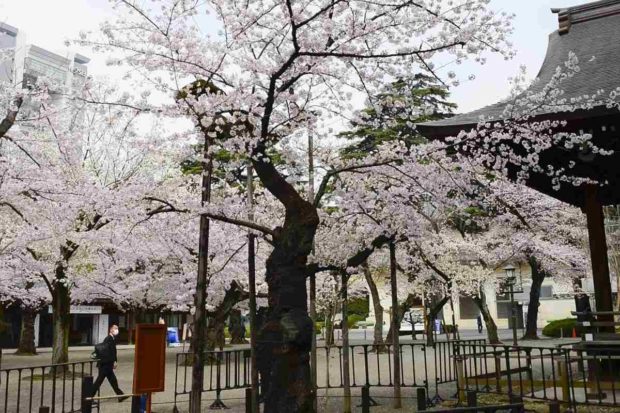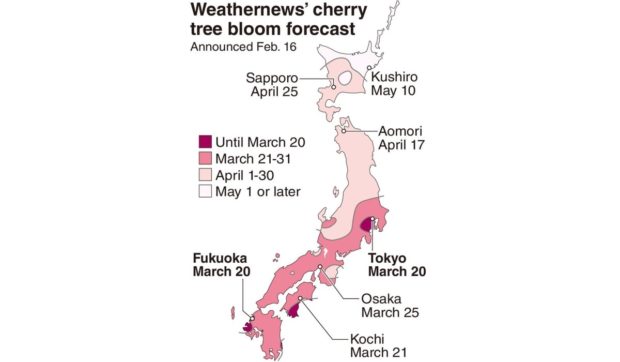Tokyo may see Japan’s earliest sakura blooms of the year

Tokyo’s sample Someiyoshino tree is seen in full bloom in the precinct of Yasukuni Shrine last March. The Japan News/Asia News Network
TOKYO — Weather companies have started releasing their bloom forecasts for the “cherry blossom front,” which is expected to begin next month.
Traditionally, cherry trees start flowering in warmer parts of Japan and gradually move northward. This year’s forecast for Tokyo, however, says the trees — known as “sakura” in Japan — could erupt into color strikingly early, and some companies are even predicting that the capital will be the first part of the country to witness an explosion of pink. But how can this be, given Tokyo’s mid-country location?
Fascinating forecasts
Weathernews Inc.’s forecast, released Thursday, predicts cherry trees will bloom in Tokyo on March 20 — the earliest expected date in Japan, along with Fukuoka Prefecture.
Weathermap Co.’s forecast, meanwhile, suggests March 17, again along with Fukuoka.
For its part, the Japan Weather Association plumps for March 22 — later than areas in Kyushu and Shikoku, but still the earliest expected date in Honshu, along with Hiroshima and other cities.
Article continues after this advertisementLast year, Weathernews predicted the nation’s first flowering in Tokyo on March 19 — the earliest forecast date in Japan. However, the capital did not see its first sakura buds open fully until March 20, later than Fukuoka (March 17) and Kochi Prefecture (March 19), but still marking Honshu’s earliest blossoming.
Article continues after this advertisementThe last time Tokyo scooped the first-in-the-country accolade was 2020, but it has been in the top five earliest-bloomer spots for the past five years.
“This year’s blooms are expected to be on par with or slightly earlier than normal across the nation, and Tokyo will lead the front,” a Weathernews spokesperson said.

The Japan News/Asia News Network
Tree-age a factor?
Some people may wonder how the cherry trees can flower so early in central Tokyo, despite the city sitting above Hiroshima and Osaka prefectures. The Weathernews spokesperson believes that the age of the baseline sample trees is affecting the blooming dates.
The Meteorological Agency’s bloom announcements are based on the status of sample trees in 58 areas of 47 prefectures. When five or six flowers can be counted on a tree, the agency deems the sakura to be in “in bloom,” and when more than 80% of the buds unfold, it declares a “full bloom.”
The Someiyoshino cultivar is used to determine official flowering dates across the nation — with Okinawa Prefecture, the Amami region and parts of Hokkaido, being the sole exceptions. However, Someiyoshino trees aged between 40 and 50 tend to flower earlier than they did when younger.
Hiroyuki Wada, a specially appointed researcher at the Flower Association of Japan, said: “Older Someiyoshino trees no longer need to pour energy into growing their trunks and leaves. They can focus more on flowering and thus bear more flowers that bloom slightly early [compared to other cherry tree strains].”
The maintenance and vigor of individual trees also plays a role in the timing of the flowering process, Wada noted.
Tokyo’s sample tree sits in the precincts of Yasukuni Shrine in Chiyoda Ward. The tree’s age cannot be verified, but it was already mature in 1966, when the meteorological agency selected it as a baseline plant, according to the shrine. To prevent the tree’s roots from weakening, the soil is softened and carefully maintained to improve ventilation and drainage, which, in Wada’s opinion, leads to its early flowering.
Rising temperatures
“We observe cherry trees in the surrounding area, too, and the sample tree doesn’t necessarily bloom earlier than the others,” an official at the meteorological agency’s Tokyo Regional Headquarters said. The official said it was likely that higher temperatures in large cities compared to regional cities were a factor, rather than there being differences between individual trees.
According to the agency, the average temperature in Japan has risen by 1.28 C over the past 100 years, whereas in central Tokyo, it has risen by 3.3 C.
Records show that Tokyo has had the nation’s earliest bloom date six times since 1953 — when statistics first became available — with four of those dates occurring after 2000. A temperature rise due to urbanization is believed to have accelerated these flowerings. The average March temperature in Tokyo during this period, however, was 9.4 C, lower than both Kagoshima Prefecture (12.8 C) and Kochi Prefecture (11.2 C). This indicates that the temperature rise is not the only reason behind Tokyo’s expeditious efflorescence.
Japan Tree Doctors Association Director Akira Kobayashi said: “It’s true that the age of the trees and the rise in temperature are factors that hasten the trees’ blossoming, but the cold of winter can also affect the blooming period. The reasons behind Tokyo’s early flowerings need to be carefully analyzed.”
RELATED STORIES
Prettier in pink: the push to remake Japan’s cherry blossom season
Sakura selfies: Tokyo enjoys cherry blossoms despite virus warning